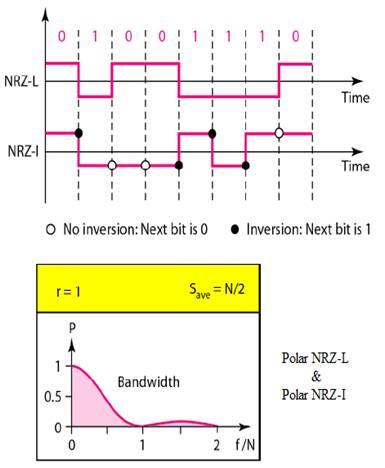Baseline Wandering: Causes and Line Coding Solutions
Advertisement
This page describes the issue of baseline wandering in digital transmission of data and explores line coding techniques used to mitigate it.
Introduction
In data communication, digital data, represented as binary ones and zeros, is transformed into digital signals (pulse shapes) before being transmitted over a channel. Line coding techniques map this digital data into different signal waveforms. Let’s look at a few examples:
- Unipolar: A binary ‘1’ is encoded as the presence of a pulse, and a binary ‘0’ as the absence of a pulse. This is also known as “ON-OFF Keying.”
- Polar: A binary ‘1’ is encoded as a positive pulse with amplitude ‘V’, while a binary ‘0’ is encoded as a negative pulse with amplitude ‘V’.
- Bipolar: A binary ‘0’ is encoded as a DC voltage, and a binary ‘1’ is encoded as either a positive or negative pulse based on alternating positions. This is also known as AMI (Alternate Mark Inversion).
These line coding techniques are further divided into NRZ (Non-Return-to-Zero) or RZ (Return-to-Zero) types based on the pulse used to represent a binary bit.
- NRZ: Binary data is represented by a pulse with a high or low level maintained throughout the entire bit duration.
- RZ: The pulse remains at a high (+V) or low level (-V) for half the bit duration and then returns to zero for the rest of the half-bit duration. The transition occurs precisely at the center of the bit period.
Figure 1 illustrates a unipolar NRZ signal waveform and its normalized power calculation.

Normalized power is double in unipolar NRZ compared to polar NRZ. Due to this reason, NRZ is not used in data communication domain.
Figure 2 depicts a polar NRZ signal and its subtypes: NRZ-L and NRZ-I.

As shown, in NRZ-L also known as NRZ-Level, level of the voltage determines value of bit. In NRZ-I also known as NRZ-Invert, change or lack of change in the level of voltage determines value of bit. If there is no change than the bit is 0 and when there is a change, the bit is 1.
What is Baseline Wandering?
The average signal power at the receiver is considered the “baseline.” The value of a data element at the receiver is determined against this baseline reference. If there are long strings of ones and zeros in the data, it drifts baseline and makes it tough for the receiver to decode the data correctly. This drift in the baseline is known as “baseline wandering.”
Let’s understand the issue of baseline wandering in NRZ-L and NRZ-I.
- NRZ-L: Due to long strings of 0s and 1s, the average power becomes high, making it difficult for the receiver to differentiate bit values.
- NRZ-I: Long sequences of 0s cause baseline wandering.
Line Coding Techniques to Eliminate Baseline Wandering
Manchester and differential Manchester techniques are commonly used to eliminate baseline wandering.
Manchester Encoding: Combines the concepts of RZ and NRZ-L. The bit duration is divided into two halves. In the first half, the voltage is at one level, and in the second half, it’s at the other level. The transition at the center of the bit period aids in synchronization.
Differential Manchester Encoding: Combines RZ and NRZ-I. There’s a transition at the center of the bit period. Bit values are determined at the beginning of the bit. If the next bit is zero (‘0’), there is a transition; if the next bit is one (‘1’), there is no transition.

Manchester line coding overcomes the issues observed in NRZ-L, while differential Manchester overcomes those observed in NRZ-I.
Advertisement
 RF
RF







